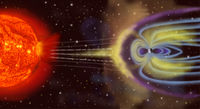
Photo from wikipedia
In this study, we measured and analyzed the spectral characteristics of a low-frequency magnetic field (MF) inside several gasoline-powered cars while driving on busy city roads. The spectra obtained upon… Click to show full abstract
In this study, we measured and analyzed the spectral characteristics of a low-frequency magnetic field (MF) inside several gasoline-powered cars while driving on busy city roads. The spectra obtained upon measurements in the interior of the cars are compared with those measured in office locations at different times of the day and with different disturbances of the geomagnetic field (k-index of disturbance 2-8). The power spectral density of the electromagnetic field in cars moving on busy roads in the frequency range of 10-3 -102 Hz is one to three orders of magnitude higher than that in urban offices. This raises a question regarding the possible influence of these MFs on the psychophysiological state of drivers. In turn, in the daytime, the MF power in the range from 10-3 to 1 Hz inside the locations is three times higher compared with the power of a strong geomagnetic storm. Despite such an overwhelming magnetic background, geomagnetic storms affect various organisms. The nonspecific effect of magnetic storms is supposed to be associated with relatively long (lasting several hours or more [frequency range of 10-4 -10-5 Hz]) periods of enhancement or weakening of the local geomagnetic field. In this range, especially at night, the power spectral density of geomagnetic disturbances is comparable to and can even exceed the power density of urban MFs. © 2020 Bioelectromagnetics Society.
Journal Title: Bioelectromagnetics
Year Published: 2020
Link to full text (if available)
Share on Social Media: Sign Up to like & get
recommendations!